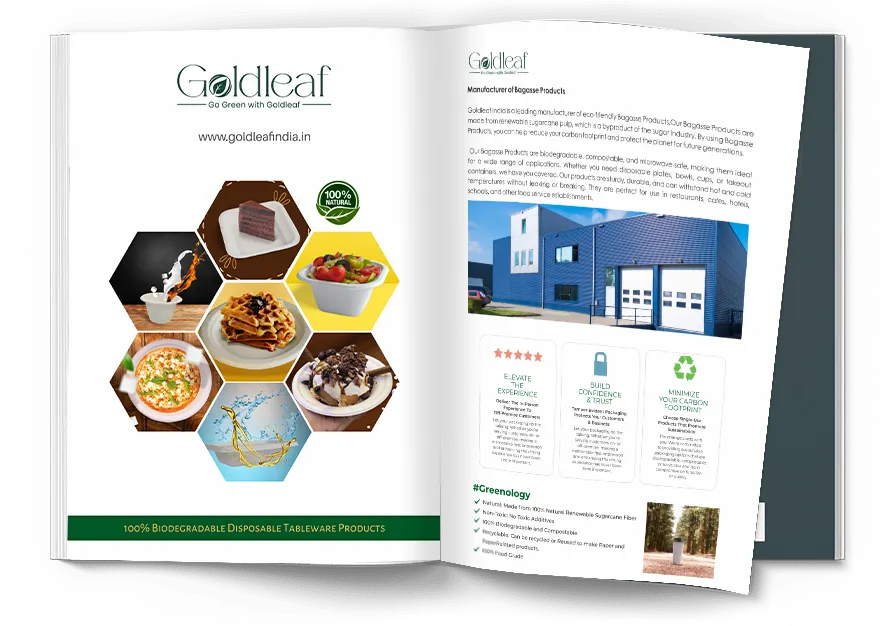Conéctese con nuestro equipo

- 654
In today’s eco-conscious world, more consumers and food businesses are looking for sustainable alternatives to plastic packaging. One material leading this green revolution is bagasse a natural byproduct of sugarcane processing. From bagasse plates to bagasse takeaway boxes, this eco-friendly material has made its way into restaurants, catering services, and even household kitchens.
But a common question arises: Are bagasse products safe for reheating food? Let’s find out.
What Are Bagasse Products?
Bagasse is the fibrous residue left after extracting juice from sugarcane. Instead of discarding this byproduct, manufacturers repurpose it into sturdy and compostable tableware and packaging. You’ll find bagasse plates, bowls, trays, boxes, and clamshell containers commonly used in takeaways and eco-friendly restaurants.
The key advantage of bagasse packaging lies in its sustainability. Unlike plastic or Styrofoam, bagasse is fully biodegradable and composts naturally without releasing harmful toxins into the environment.
How Are Bagasse Products Made?

The process begins with cleaning and pulping sugarcane fibers, which are then molded under heat and pressure to create durable shapes. The result? Natural, chemical-free bagasse containers and bagasse food packaging that are heat-resistant, grease-resistant, and safe for direct contact with food.
Because they’re made from natural fibers, bagasse products don’t contain BPA, plasticizers, or other synthetic compounds often found in conventional packaging.
Are Bagasse Products Safe for Reheating Food?
Yes, absolutely. Bagasse products are designed to withstand high temperatures typically up to 200°C (392°F). This makes them safe for reheating food in both microwave ovens and conventional ovens.
Unlike plastic containers that can melt or release harmful chemicals when heated, bagasse remains stable. It doesn’t leach toxins into your food or alter its taste. That’s why many food businesses are shifting from plastic packaging to bagasse boxes and sugarcane containers for both serving and reheating purposes.
Can You Use Bagasse Containers in Microwaves and Ovens?
Yes, but with a few precautions. Bagasse packaging is microwave-safe for short durations typically up to 2-3 minutes, depending on food moisture and portion size. For oven use, ensure the temperature stays below 200°C and limit heating time.
Avoid reheating meals that are extremely oily or liquid-heavy for long periods, as this may weaken the structure of the container. Always follow the heating recommendations provided by the manufacturer.
How Do Bagasse Products Compare to Other Food Packaging?
Bagasse packaging offers a superior balance of safety, performance, and sustainability compared to conventional materials.
| Packaging Type | Safety & Heat Resistance | Environmental Impact |
|---|---|---|
| Plastic Containers | May release BPA or toxins when heated | Non-biodegradable, polluting |
| Styrofoam | Melts or releases styrene under heat | High carbon footprint |
| Paper Products | Limited heat resistance, may weaken | Biodegradable but less durable |
| Aluminum | Excellent heat resistance | High energy use in production |
| Bagasse | Safe for reheating, non-toxic, sturdy | Fully biodegradable & compostable |
In conclusion, bagasse containers outperform plastics and Styrofoam in both food safety and environmental performance, making them ideal for microwave-safe, non-toxic food packaging.
What Makes Bagasse a Safer Choice for Food Reheating?

Here’s why bagasse containers and bagasse bowls are safer than most alternatives:
• Non-toxic: No BPA, phthalates, or petroleum-based coatings.
• Grease and moisture resistance: Keeps food fresh and prevents leakage.
• Heat tolerance: Retains shape even under high temperatures.
• Chemical-free: Made from natural sugarcane fibers without artificial additives.
These qualities ensure your food remains safe and chemical-free, even after reheating.
Environmental and Health Benefits of Bagasse Packaging
When you choose bagasse trays or bagasse takeaway boxes, you’re not just protecting your health you’re helping the planet too. Bagasse decomposes completely within 90 days in composting conditions, turning into natural fertilizer for soil. It reduces waste in landfills and lowers the carbon footprint compared to single-use plastics.
Health-wise, using bagasse food containers eliminates the risk of toxic exposure during reheating something that’s common with plastic and Styrofoam products.
Common Uses of Bagasse Food Containers
• Restaurants & Cafés: For serving and delivering hot meals.
• Catering Services: As eco-friendly buffet trays and bowls.
• Home Kitchens: For microwave-safe reheating or storing leftovers.
Their strength, thermal resistance, and compostable nature make bagasse clamshells and plates ideal for both business and household use.
What Are the Best Practices for Reheating Food in Bagasse Containers?
To ensure safety and maintain food quality, follow these reheating best practices:
• Maintain temperature below 200°F (93°C).
• Heat food for short durations (under 3 minutes) in the microwave.
• Avoid reheating soups, oily dishes, or liquid-heavy foods for extended periods.
• Store food in a cool, dry place before reheating.
• Discard containers that appear softened, discolored, or cracked after use.
Foods like rice, pasta, and dry snacks reheat well in bagasse, while greasy or watery foods should be reheated with caution.
Conclusion
So, are bagasse products safe for reheating food?
Yes they are not only heat-safe but also non-toxic, biodegradable, and environmentally responsible. Whether you’re using bagasse trays, clamshells, or bowls, you can reheat your meals with peace of mind.
Switching to sugarcane-based packaging is more than a convenience it’s a commitment to a healthier planet and a safer lifestyle.
© 2024 , Goldleaf ,
Reservados todos los derechos.
Made & Managed by Lightlink Solutions




